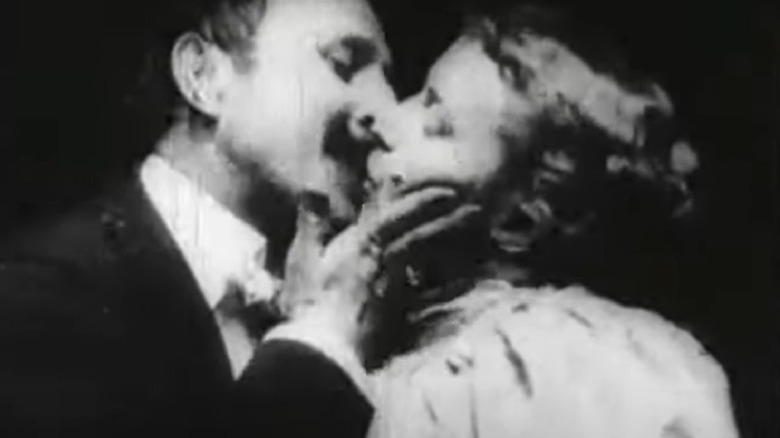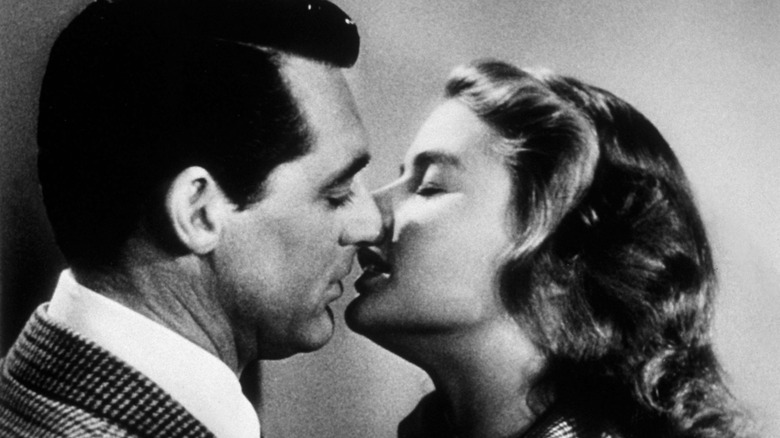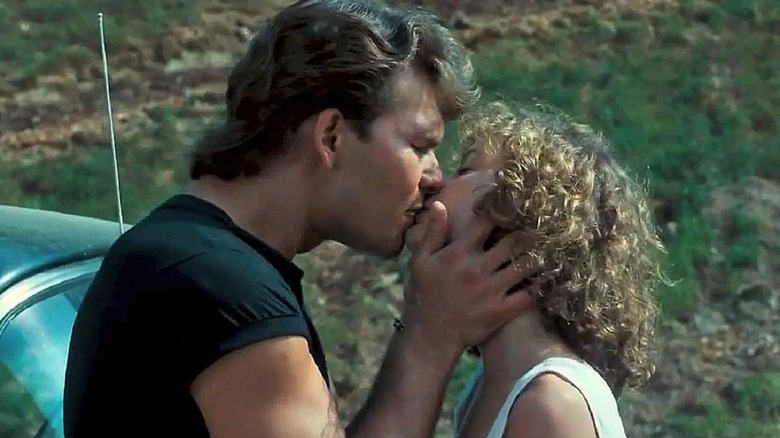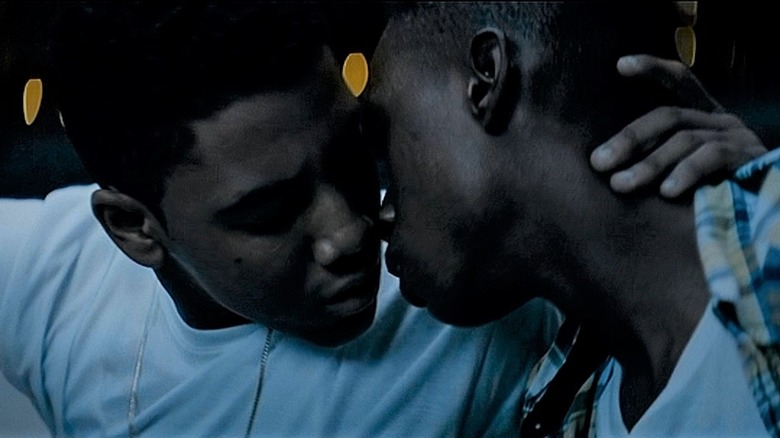The History Of Kissing In Movies Explained
This content was paid for by Netflix and created by Looper.
There's nothing quite like a warm smooch session to bring some real sizzle to the screen. A good movie kiss can make all the difference in solidifying a character's romantic journey, and sometimes, there are even entire movies devoted to making some much-needed lip-lock action finally happen.
"The Kissing Booth" fans have been treated to an absolute abundance of kisses throughout the film series, with most of the characters puckering up at some point or another, thanks in no small part to the hit carnival booth that started it all. And there's also a wide range of the types of kisses involved in the films, from polite little pecks to steamy make-out moments and everything in between. There are simply no limits to the amount of heat you might see during the many canoodling sessions in "The Kissing Booth" movies.
But movies haven't always been able to bring such sultry, voluminous, or even casual kissing scenes into the picture. In fact, there used to be some pretty hard and fast rules about exactly how a screen smooch could unfold, and it took decades for things to change. So, to celebrate the vibrant variety of on-screen kisses in "The Kissing Booth," here's a look back at the history of movie kisses.
A bold beginning
The very first movie kiss arrived all the way back in 1896 in a short film called "The May Irwin Kiss." The seconds-long footage was filmed in the studio of kinetoscope inventor Thomas Edison and featured actors May Irwin and John Rice — who were already co-stars of the stage musical "The Widow Jones" — sharing a short smooch. This footage is not to be confused with Edison's 1900 pic "The Kiss," which also featured two actors nuzzling up very briefly with big smiles, although they do look pretty similar given the grainy black-and-white film textures. And in 1898, Saint Suttle and Gertie Brown became the first Black actors to share an on-screen kiss, although this footage was only rediscovered in 2017. All three shorts showcased the brevity and cheekiness of the captured kisses of the era, along with the limited camera angling available to the earliest auteurs.
As moviemaking technology improved, so did the length of films. Soon, movies lasted much longer than a matter of seconds, and the length and intensity of screen kisses did as well. In the roaring '20s, there were a number of films that brought some real heat to their kissing scenes and made big stars out of those actors who could truly steam up the screen. Looking back, you might be surprised to see how impassioned some of the scenes from films of the era really were. Consider the seduction scene in 1922's "Blood and Sand" and the captivating will-they-or-won't-they moment from 1928's "The Mysterious Lady." There were also some major movie milestones to be achieved early on, like the first same-sex kiss in 1927's "Wings." So kissing scenes were getting pretty intense right from the start in Hollywood. However, the onslaught of on-screen romance caused a huge backlash in the decade to follow.
The demure era
In 1930, in response to growing pressure and boycotts from certain religious and morality groups, the Hays Code was adopted and explicitly forbade "excessive and lustful kissing" — along with profanity, nudity, interracial romances, and more — from being shown on-screen. With the threat of their pics being banned from theaters looming large, filmmakers had to adapt to this stiff production code, and movie kisses were only allowed to last a few seconds at a time. Some directors found clever ways to skirt the rules. For instance, Alfred Hitchcock had actors Cary Grant and Ingmar Bergman play out their nearly three-minute-long kissing scene in the 1946 film "Notorious" with playful interruptions to adhere to the rule, and it actually made the kiss even more iconic as a result. But for others, this restrictive set of rules meant movie kisses were briefer and more sanitized than those in some of the earliest films of the industry.
Though many films from the '30s until the '60s were pretty closed-lip when it came to movie kisses, there were still some very memorable kissing scenes to emerge from the era, including in films like "Casablanca," "The More the Merrier," "To Have and to Have Not," "From Here to Eternity," and "Lady and the Tramp." But things really started to heat up on-screen once the concept of free love began sweeping the nation, rendering the rules of old moot.
An experimental age
By the late '60s, the Hays Code was history, and films started to get much freer and friskier, with movies like "Midnight Cowboy," "The Graduate," "The Rocky Horror Picture Show," and "Harold and Maude" breaking the mold about what types of stories movies were meant to tell. At the same time, kissing scenes became more extensive and provocative. They even became some of the defining moments of blockbuster action movies, like the "James Bond" films and "The Thomas Crown Affair," which didn't hold back with close-up camera work that showed off every possible angle of the romance at hand.
The '70s and '80s became a true heyday for romantic dramas, with swoony smooches emerging as a top priority for love stories. In fact, these movies weren't only free to show extended-length kisses with heightened intensity, they were also pressured to ramp up the importance of those exchanges. Some of the movies with the most memorable screen kisses from the era included "Love Story," "The Way We Were," "Grease," and "Sixteen Candles." And we've also got to mention classics like "Dirty Dancing," "The Princess Bride," "Say Anything," and "When Harry Met Sally." By the time the 1990s arrived, it seemed like nothing was off-limits when it came to on-screen kisses, and yet movies have still continued to raise the bar on what's possible for kissing scenes.
The modern mold
From the 1990s onward, movies became even more bold and inclusive when it came to their romantic narratives. The success of '90s films like "Pretty Woman," "Ghost," "Poetic Justice," "Waiting to Exhale," and "Soul Food" assured variety and inclusion was the spice of life when it came to love stories. By the turn of the millennium, teen films also dared to take down taboos with racy movies like "Wild Things," "Cruel Intentions," and "American Pie" breaking down barriers about how much sexuality could be shown in films. Even more classical love story fare — like the spate of Nicholas Sparks movies, the classic "Spider-Man" romance between Peter Parker and Mary Jane Watson, and sweeping romances like "Romeo + Juliet" and "Titanic" — had to get creative when it came to the setup and scenery of their smooches if they wanted to stand out amid the increasingly competitive screen kissing scene.
In the years since, Hollywood has continued to broaden its own horizons when it comes to screen kisses. For example, the commercial and critical successes of films like "Brokeback Mountain," "Blue Is the Warmest Color," and "Moonlight" — each of which contain instantly iconic kissing scenes — marked some major breakthroughs for LGBTQ+ representation in romantic stories. And cast lists are becoming far more diverse than in decades past, with recent romantic movie hits like "To All the Boys I've Loved Before," "Crazy Rich Asians," "Always Be My Maybe," "The Lovebirds," and "Happiest Season" all being headlined by people of color or LGBTQ+ actors.
Nowadays, it seems that there are no limits to who can kiss who and for how long in films. It might've taken decades for movies to get to the point where it's completely commonplace for so many kinds of kisses to make it to screen, but in "The Kissing Booth" films, the characters sure do have some fun trying out a variety of kissing partners.



